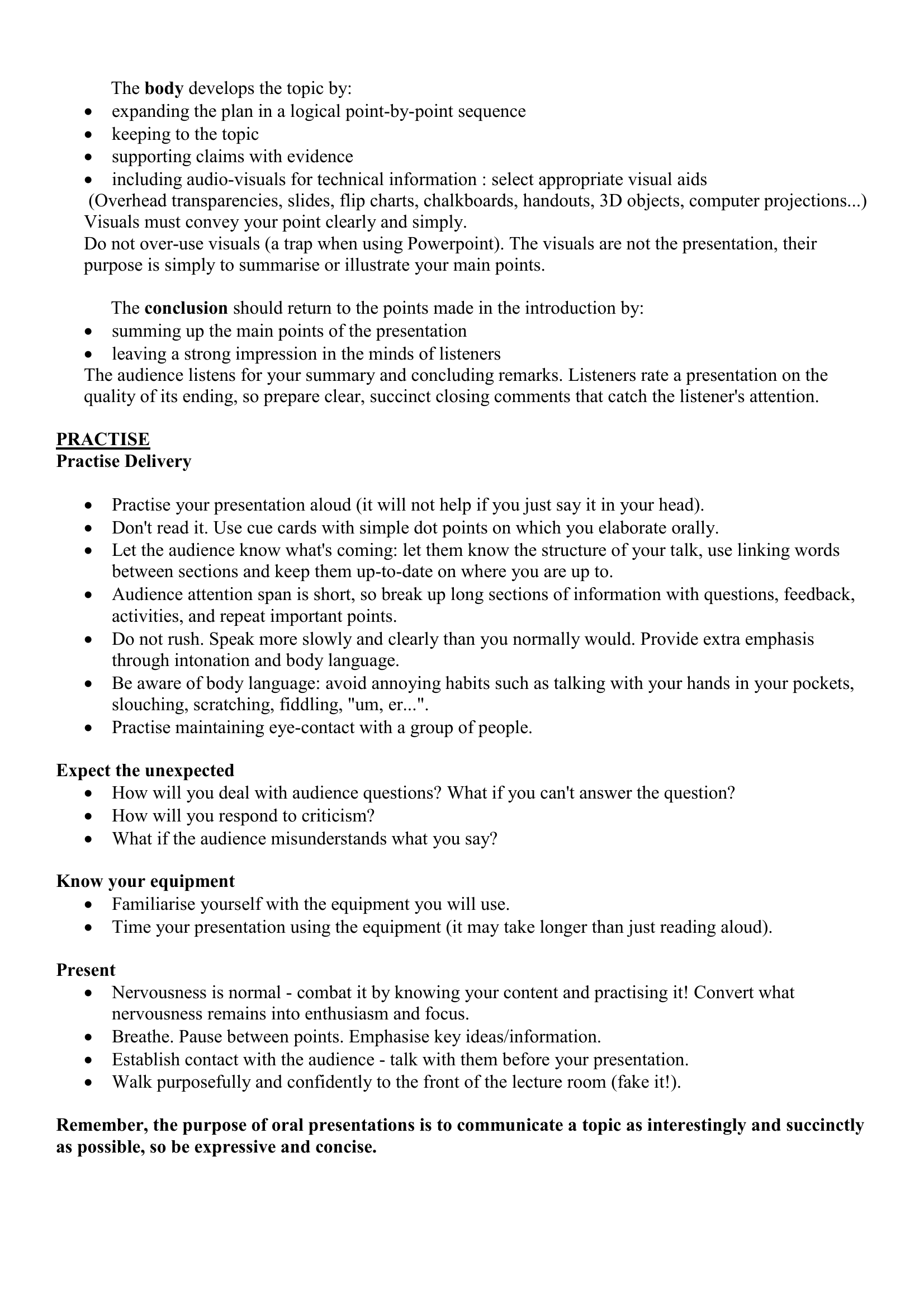A guide to oral presentations
Publié le 02/11/2011
Extrait du document
The message is simple: PREPARE! PREPARE! PREPARE!
PLAN
Analyse your audience
- What do they know about the subject? What terminology would they know?
- What do they want or need to know? What is their motivation for listening to you?
- What aspects of your subject would they be interested in?
- How much information can they absorb? If they are new to the topic, their level of absorption may be lower than for an expert audience.
Determine primary purpose
- What is your main point? (Can you put it into one sentence?)
- What do you want your listeners to do or think? (Are you trying to inform/convince/guide/entertain them?)
«
The body develops the topic by:
expanding the plan in a logical point-by-point sequence
keeping to the topic
supporting claims with evidence
including audio-visuals for technical information : select appropriate visual aids
(Overhead transparencies, slides, flip charts, chalkboards, handouts, 3D objects, computer projections...)
Visuals must convey your point clearly and simply.
Do not over-use visuals (a trap when using Powerpoint).
The visuals are not the presentation, their
purpose is simply to summarise or illustrate your main points.
The conclusion should return to the points made in the introduction by:
summing up the main points of the presentation
leaving a strong impression in the minds of listeners
The audience listens for your summary and concluding remarks.
Listeners rate a presentation on the
quality of its ending, so prepare clear, succinct closing comments that catch the listener's attention.
PRACTISE
Practise Delivery
Practise your presentation aloud (it will not help if you just say it in your head).
Don't read it.
Use cue cards with simple dot points on which you elaborate orally.
Let the audience know what's coming: let them know the structure of your talk, use linking words
between sections and keep them up-to-date on where you are up to.
Audience attention span is short, so break up long sections of information with questions, feedback,
activities, and repeat important points.
Do not rush.
Speak more slowly and clearly than you normally would.
Provide extra emphasis
through intonation and body language.
Be aware of body language: avoid annoying habits such as talking with your hands in your pockets,
slouching, scratching, fiddling, "um, er...".
Practise maintaining eye-contact with a group of people.
Expect the unexpected
How will you deal with audience questions? What if you can't answer the question?
How will you respond to criticism?
What if the audience misunderstands what you say?
Know your equipment
Familiarise yourself with the equipment you will use.
Time your presentation using the equipment (it may take longer than just reading aloud).
Present
Nervousness is normal - combat it by knowing your content and practising it! Convert what
nervousness remains into enthusiasm and focus.
Breathe.
Pause between points.
Emphasise key ideas/information.
Establish contact with the audience - talk with them before your presentation.
Walk purposefully and confidently to the front of the lecture room (fake it!).
Remember, the purpose of oral presentations is to communicate a topic as interestingly and succinctly
as possible, so be expressive and concise..
»
↓↓↓ APERÇU DU DOCUMENT ↓↓↓
Liens utiles
- Sujet d'Oral : Comment les bateaux flottent-ils ?
- Grand Oral: Le nombre d’or
- oral louise labé je vis je meurs
- Oral brevet : "Tres de Mayo », Francisco Goya
- analyse linéraire pour l'oral du bac sur le text liminaire de l'épitre dédicatoire de Louise Labé

































